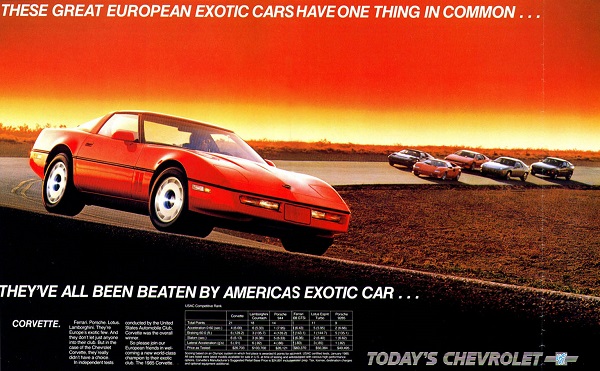Corvette History through Ads: Europe Blinked
Obviously the same government regulations that impeded straight-line performance for the fourth generation of America’s sports car also limited competitors cars as well. Dave McLellan, Corvette’s chief engineer from 1975 until his retirement in 1992, understood the impact strict CAFE (Corporate Average Fuel Economy) and safety government regulations dictated, and though challenging, he recognized that it presented an opportunity: to design and build a new Corvette that would beat the competition soundly. McLellan’s design and engineering focus for the new generation Corvette was clearly on handling. To say McLellan’s strategy worked would be an understatement.
The Corvette engineers infused the new Vette with the most revolutionary technology and lightweight materials with the objective of transforming the Corvette into an outstanding performer on the track but also one that would clearly set the standard for sports cars throughout the world. They focused on important areas such as handling, braking, slalom speed, lateral acceleration, and even acceleration in addition to dramatically improved aerodynamics and mass reduction. An all new rigid and structurally integrated frame was designed which allowed the engineers to redesign the suspension and lower the engine position in the frame. Lightweight aluminum was used extensively on the chassis and suspension parts. Even a special “uni-directional” tire was produced for the car. Every suspension component was analyzed and reviewed using the guidelines of “form follows function.”
Jerry Palmer, lead designer, and his team were challenged to improve aerodynamics and reduce weight to help improve both performance and fuel economy. The designers claimed that the car was “designed in the wind tunnel” and though that may be an exaggeration, the design was extensively tested and refined in the wind tunnel. The windshield was raked to a 64 degree angle, the Corvette’s iconic hidden headlights continued, the car was shortened by 8.75 inches and the wheelbase also reduced two inches. In addition the hood line was lowered, enabled by the lower position of the engine, which resulted in reducing the overall frontal area of the car. The tail end of the C4 was shortened by over five inches. All of this combined for a major improvement in aerodynamic drag. The new C4 design had a drag coefficient (Cd) of .34 compared to the C3 at .44, almost a 25% improvement in aerodynamic efficiency.
Additionally, lightweight components reduced weight by 250 pounds. These improvements returned big dividends and helped the car achieve state of the art handling. In 1985 the marketing department developed a compete marketing program around the new car’s performance capabilities building both a series of print advertisements and television commercials touting the C4’s results in a comparison test with some of the most impressive exotic sports cars in the world.
One of the most effective ads showed the frontal view of a 1985 C4 with the headline: “Corvette. The American that went eye to eye with Europe… and Europe blinked.” The advertisement showed a chart comparing the results of trials conducted by the United States Auto Club comparing the new Corvette C4 and the Porsche 944, Porsche 928S, Lamborghini Countach, Lotus Esprit Turbo, Ferrari 308 GTSi in acceleration, braking, slalom speed, lateral acceleration and price. The Corvette was the clear winner. There was even a TV commercial based on the test results.
Clearly the results achieved by both McLellan and Palmer following the age old design philosophy of “form follows function” paid big dividends. In an era when designing a performance car faced several challenges America’s “exotic” sports car rose to the challenge, stood tall and outperformed the competition.



